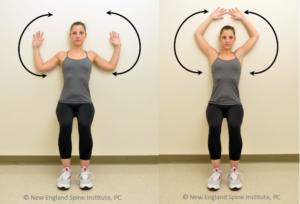
By Kure Clinic
Tired of that nagging sharp pain in your shoulders that stops you from even completing your daily chores? This pain could be a symptom of your, dealing with a frozen shoulder. So let’s dwell to understand what a frozen shoulder is and discover solutions to get rid of it through chiropractor and physiotherapy.
Adhesive capsulitis colloquially called frozen shoulder can be simply explained as the formation of adhesions around the shoulder joint that affects the normal range of motion causing pain, dysfunction, and limitation in performing typical day-to-day work. The shoulder joint is enclosed within a capsule. The stiffness or contracture of the shoulder joint capsule is the hallmark of a frozen shoulder. An inflammatory process is probably known to happen during this process. Usually, the prognosis is quite satisfying in most cases, but the recovery could vary from person to person and could range up to two or three years. The presentation of symptoms is sudden but the recovery occurs in a gradual manner.
Physical examinations like asking the patient to touch his scapula from behind the back and the neck are commonly utilized to a lot extent to mimic the complaints of inability to fasten one’s back buttons, do overhead activities, brush one’s hair, take a wallet from back pocket, etc. are reported by the patients. Concomitantly, the patient also complains of neck pain. It may be due to the overuse of cervical muscles/neck musculature to overcompensate for the lack of movement in the shoulder complex.












DO YOU HAVE FROZEN SHOULDER ?? KNOW IT NOW THROUGH THIS VIDEO
As the name suggests, ‘frozen’ indicates restrictions and limitations, likewise is the concept behind the name frozen shoulder.
Prolonged immobilization of the shoulder joint can trigger thickening and adhesions around the capsular sheath of the shoulder which ultimately results in tightening and tension build-up around the shoulder. The humerus (bone in the upper arm) gets less space to pivot hence restricting the shoulder range of movement.
You could be suffering from either primary or secondary adhesive capsulitis. Your physiotherapist would be able to rule out the same, as the primary frozen shoulder is developed without any history of inciting factors or trauma. Whereas the secondary type shows a history of trauma or injury.
Talking about those who fall in the high-risk category are
Immobility is reinforced due to prevailing conditions like
can also predispose the individual to develop a frozen shoulder.
There are three classical stages in which the frozen shoulder unfolds.
Firstly you will enter the ‘pain phase’ where you might experience pain eliciting at night hours but preserved ranges.
Secondly comes the ‘stiffness phase’. The complaints could be capsular tightness and loss of range of motion. External rotation is the primary and first range to be affected in this stage.
Finally, the ‘thawing stage’ is when the ranges start coming back to normal, but gradually and pain might start to subside.
The basic regimen to stretch and strengthen remains the essential step. But every other body is designed and affected in different aspects. Instead of driving aimlessly and doing every exercise ( that may deteriorate the present condition) you can visit our Kure clinic, and let us take your treatment for the best results. We offer a complete evaluation and assessment of your shoulder and other related joints. The goal of our treatment is to restore the shoulder ranges to normal allowing painless functional rhythm.
With the best association of an orthopedic surgeon, physiotherapist, and chiropractor, an appropriate and timely treatment protocol can help regain shoulder movement.
Chiropractic adjustments are also a win-win if there’s any joint malalignment present. With a methodological approach.
Combining physiotherapy and chiropractic treatment, you will notice what a good and healthy shoulder feels like.